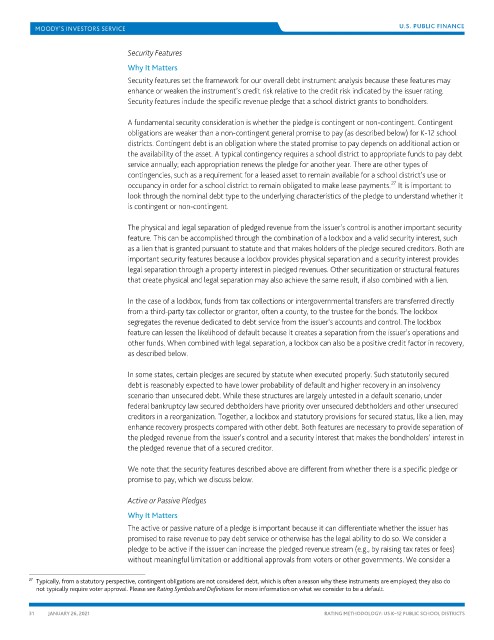Page 1669 - draft
P. 1669
U.S. PUBLIC FINANCE
Security Features
Why It Matters
Security features set the framework for our overall debt instrument analysis because these features may
enhance or weaken the instrument’s credit risk relative to the credit risk indicated by the issuer rating.
Security features include the specific revenue pledge that a school district grants to bondholders.
A fundamental security consideration is whether the pledge is contingent or non-contingent. Contingent
obligations are weaker than a non-contingent general promise to pay (as described below) for K-12 school
districts. Contingent debt is an obligation where the stated promise to pay depends on additional action or
the availability of the asset. A typical contingency requires a school district to appropriate funds to pay debt
service annually; each appropriation renews the pledge for another year. There are other types of
contingencies, such as a requirement for a leased asset to remain available for a school district’s use or
occupancy in order for a school district to remain obligated to make lease payments. It is important to
27
look through the nominal debt type to the underlying characteristics of the pledge to understand whether it
is contingent or non-contingent.
The physical and legal separation of pledged revenue from the issuer’s control is another important security
feature. This can be accomplished through the combination of a lockbox and a valid security interest, such
as a lien that is granted pursuant to statute and that makes holders of the pledge secured creditors. Both are
important security features because a lockbox provides physical separation and a security interest provides
legal separation through a property interest in pledged revenues. Other securitization or structural features
that create physical and legal separation may also achieve the same result, if also combined with a lien.
In the case of a lockbox, funds from tax collections or intergovernmental transfers are transferred directly
from a third-party tax collector or grantor, often a county, to the trustee for the bonds. The lockbox
segregates the revenue dedicated to debt service from the issuer’s accounts and control. The lockbox
feature can lessen the likelihood of default because it creates a separation from the issuer’s operations and
other funds. When combined with legal separation, a lockbox can also be a positive credit factor in recovery,
as described below.
In some states, certain pledges are secured by statute when executed properly. Such statutorily secured
debt is reasonably expected to have lower probability of default and higher recovery in an insolvency
scenario than unsecured debt. While these structures are largely untested in a default scenario, under
federal bankruptcy law secured debtholders have priority over unsecured debtholders and other unsecured
creditors in a reorganization. Together, a lockbox and statutory provisions for secured status, like a lien, may
enhance recovery prospects compared with other debt. Both features are necessary to provide separation of
the pledged revenue from the issuer’s control and a security interest that makes the bondholders’ interest in
the pledged revenue that of a secured creditor.
We note that the security features described above are different from whether there is a specific pledge or
promise to pay, which we discuss below.
Active or Passive Pledges
Why It Matters
The active or passive nature of a pledge is important because it can differentiate whether the issuer has
promised to raise revenue to pay debt service or otherwise has the legal ability to do so. We consider a
pledge to be active if the issuer can increase the pledged revenue stream (e.g., by raising tax rates or fees)
without meaningful limitation or additional approvals from voters or other governments. We consider a
27 Typically, from a statutory perspective, contingent obligations are not considered debt, which is often a reason why these instruments are employed; they also do
not typically require voter approval. Please see Rating Symbols and Definitions for more information on what we consider to be a default.
31 JANUARY 26, 2021 RATING METHODOLOGY: US K–12 PUBLIC SCHOOL DISTRICTS

